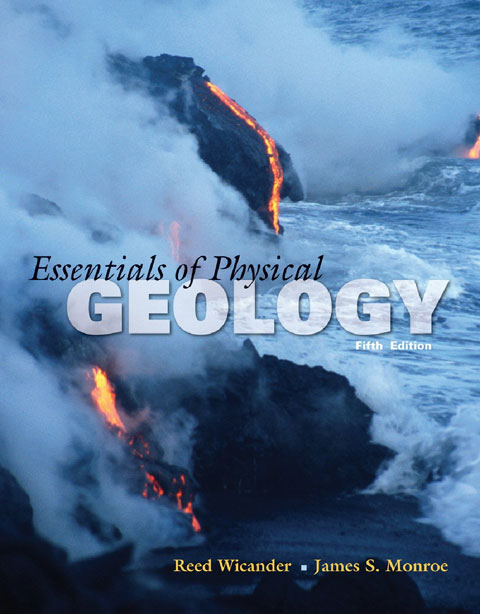
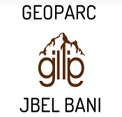
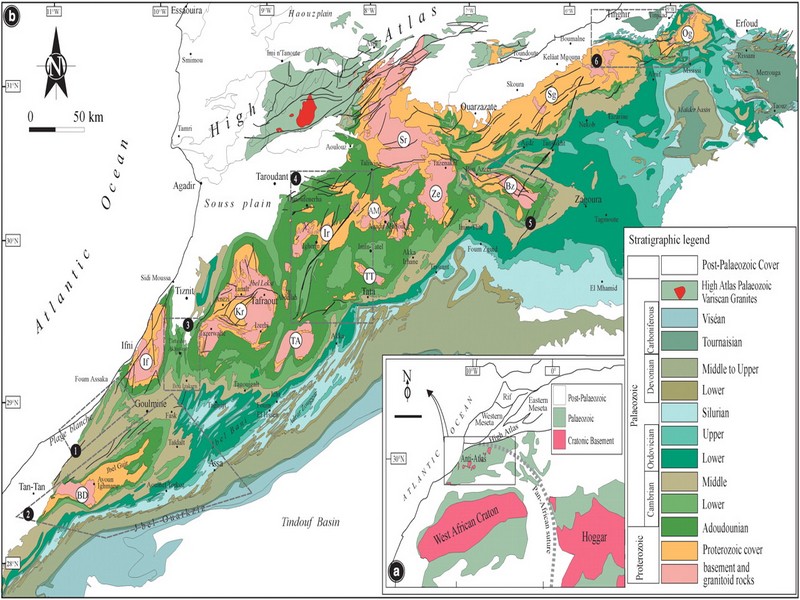
A short overview of the Anti-Atlas, Morocco
DR.Hervé Rezeau, DR.Cyril Chelle-Michou & DR.Michael Calder
SEG Student Chapter of Geneva (Switzerland)
SEG Student Chapter of Montpellier (France)
INTRODUCTION
Geology of Morocco has been subdivided into four structural domains, from north to south they are the following: the Rif domain, the Meseta domain, the High Atlas, and the Anti-Atlas, as they are shown in (Figure 1).
The Rif Range extends along the Mediterranean coast from the Kabylian-Tellian belts up to the Strait of Gibraltar. South of it, the Meseta domain is located, where elevated plateaus and intramontane basins occur. Further south the High Atlas system is found, which displays several massifs close to 4000 m, including the highest peak of northern Africa (Jebel Toubkal). The Middle Atlas represents a branch of the Atlas system that extends obliquely across the Meseta domain, and exceeds 3000 m in elevation. Finally, the Anti-Atlas domain is found, which rises forming a massive mountain that achieves up to 2700 m. Further south the elevation decreases both southward and westward from ca. 1000 m to less than 200 m close to the Atlantic.
Figure 1: Elevation map of Morocco and neighbouring countries from GTOPO30 database (A. Michard et al. 2008)
GEOLOGICAL SETTING OF THE ANTI-ATLAS
The Anti-Atlas mountain belt is located in the northern part of the West African Craton (WAC). It is stretching NE-SW and is characterized by Precambrian to late Proterozoic rocks covered by younger sediments of Edicaran to Cambrian in age. The geological boundary between the Anti-Atlas and High Atlas is structurally marked by the South Atlas fault (SAF) (Fig.2). The Anti-Atlas massif is a zone of wide domal uplift with much weaker Alpine age deformation. The volcanics and conglomerates rocks from the Ouarzazate & Bou Salda group in the North-East are surrounding the older volcanics rocks
The Anti-Atlas mountain belt is located in the northern part of the West African Craton (WAC). It is stretching NE-SW and is characterized by Precambrian to late Proterozoic rocks covered by younger sediments of Edicaran to Cambrian in age. The geological boundary between the Anti-Atlas and High Atlas is structurally marked by the South Atlas fault (SAF) (Fig.2). The Anti-Atlas massif is a zone of wide domal uplift with much weaker Alpine age deformation. The volcanics and conglomerates rocks from the Ouarzazate & Bou Salda group in the North-East are surrounding the older volcanics rocks and turbidite sequences from the Sahgro Group and the Pan-African granite intrusions. This geomorphological feature is commonly called inliers (“boutonnière” in French) and is the result of an exposed older rock formation surrounded by younger rock, and is due to a high erosion rate of rocks with different hardness but also encouraged by deformation such as folding and faulting (Gasquet et al. 2005). Several slivers of ophiolites are present in the Anti-Atlas belt, the best preserved are situated in the Bou Azzer, Siroua and Iriri region, which represent remnant of an ocean closure. The basement is composed of schists, granites and mylonites of Paleoproterozoic age. The latest Variscan and Alpine orogenic events overprint most of the Anti-Atlas geological province and thus complicate the Pre- Cambrian geodynamic interpretation. However, two main periods of tectono-thermal magmatic activity (Gasquet et al. 2005) are now recognised :
(i)A Palaeoproterozoic period, corresponding to the Eburnean (Birimian) orogeny,
(ii)A Neoproterozoic period, corresponding to the Pan-African orogeny.
Figure 2: Schematic map of the Anti-Atlas Precambrian inliers (Boutonnière), and location of the maps, satellite views and lithospheric profile presented hereafter (Gasquet et al. 2008)
Source web : DR.Hervé Rezeau, DR.Cyril Chelle-Michou & DR.Michael Calder unige.ch
Les articles en relation

Scincus scincus, le poisson du Désert
Egalement connu sous le nom de poisson des sables, poisson du désert ou de lézard des sables, le Scincus scincus (scinque) est un reptile qui mesure jusqu’à 25 cm de longueur. Parfaitement adapté au cli
Savoir plus...
Le Roi de tous les Antioxydants
Le Roi de tous les Antioxydants Nous avons tous entendu parler des antioxydants, mais connaissons-nous le roi de tous les antioxydants ? Celui qui est le secret pour éviter le cancer, les maladies cardiaques, le vieillissement
Savoir plus...
Situation géographique et bases géologiques pour Charles Robert-Charrue
Situation géographique et bases géologiques pour Charles Robert-Charrue Au Nord-ouest du continent africain, l’Anti-Atlas constitue le domaine austral du Royaume du Maroc. Comme le suggère l’image sat
Savoir plus...
Le Pommier de Sodome
Le Pommier de Sodome Très fréquent au Maroc dans les régions arides, le Pommier de Sodome (Calotropis procera) est très utilisé dans la pharmacopée traditionnelle malgré sa toxicit&eac
Savoir plus...
Le festival des fiançailles d’Imilchil: Mariage et folklore
Le festival des fiançailles d’Imilchil: Mariage et folklore Dans le Haut-Atlas Oriental, le village d’Imilchil organise chaque année au mois de Septembre un festival où des centaines de jeunes filles
Savoir plus...
Comment nourrir les oiseaux en hiver ?
Comment nourrir les oiseaux en hiver ? Que ce soit en installant des mangeoires dans le jardin, sur la terrasse ou bien en leur jetant des miettes de pain, le geste de nourrir les oiseaux, en hiver ou en été, semble nat
Savoir plus...
Quelques chiffres sur l'artisanat du Maroc...
Quelques chiffres sur l'artisanat du Maroc... L'artisanat marocain reflète la richesse culturelle ancestrale propre au pays et représente un important gisement économique. De nombreux indicateurs &eacu
Savoir plus...
L’espace culturel de la place Jemaa el-Fna
L’espace culturel de la place Jemaa el-Fna Inscrit en 2008 sur la Liste représentative du patrimoine culturel immatériel de l’humanité (originellement proclamé en 2001) Pays : Maroc Descr
Savoir plus...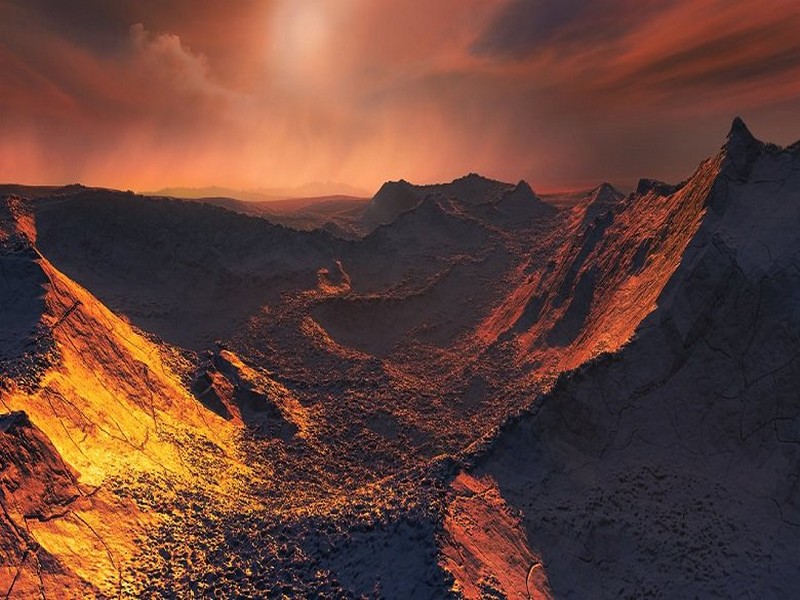
Découverte d'une nouvelle
Découverte d'une nouvelle "super-terre" pas si loin de nous Une "super-terre" a été découverte en orbite autour d'une étoile "voisine" du système solaire
Savoir plus...
Drâa-Tafilalet : des pluies bienfaitrices redonnent espoir après des années de sécheresse
Drâa-Tafilalet : des pluies bienfaitrices redonnent espoir après des années de sécheresse Errachidia – Après plusieurs années marquées par des périodes de sécheress
Savoir plus...
La symphonie d'arts populaires ouvre le festival d'Ahwach à Ouarzazate (Géoparc Jbel Bani)
La symphonie d'arts populaires ouvre le festival d'Ahwach à Ouarzazate (Géoparc Jbel Bani) OUARZAZATE (MAP) - Une symphonie d'arts populaires a ouvert, vendredi soir, la deuxième édition du fes
Savoir plus...Les tags en relation
En savoir plus sur " Géologie et TSGJB - AMDGJB "
Consulter les vidéos de " Géologie et TSGJB - AMDGJB " Consulter les photos de " Géologie et TSGJB - AMDGJB " Consulter les publications de " Géologie et TSGJB - AMDGJB " Consulter les éditions de " Géologie et TSGJB - AMDGJB " Consulter les communications de " Géologie et TSGJB - AMDGJB "Recherche du site
Recherche avancée / Spécifique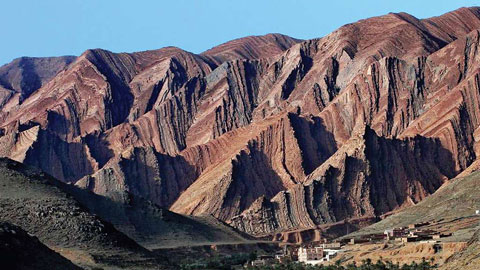
Géoparc et Recherche Scientifique
Le coins de l’étudiant
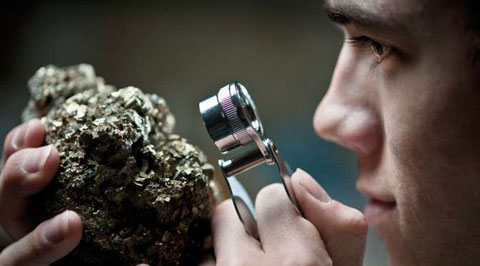


Blog Géoparc Jbel Bani
Dictionnaire scientifique
Plus de 123.000 mots scientifiques
Les publications
Géo parc Jbel Bani
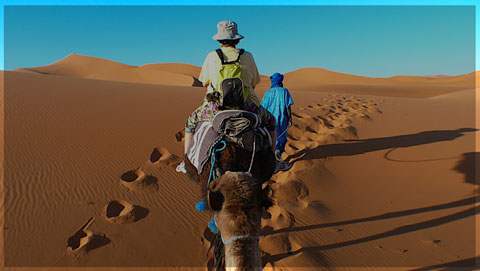
Circuits & excursions touristiques
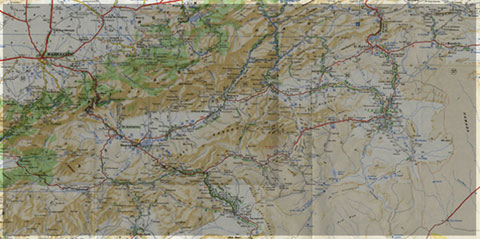
cartothéques
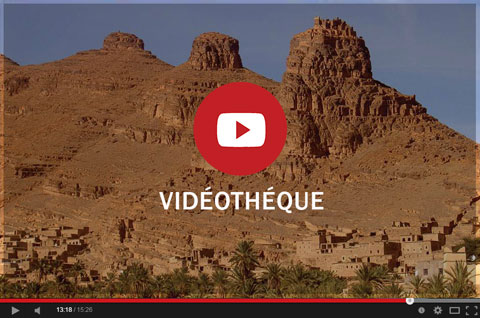
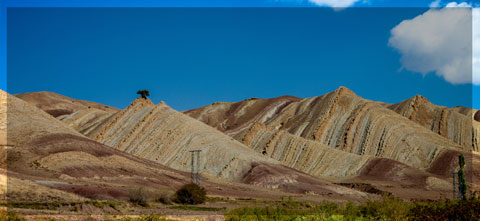
Photothéques
Publications & éditions
